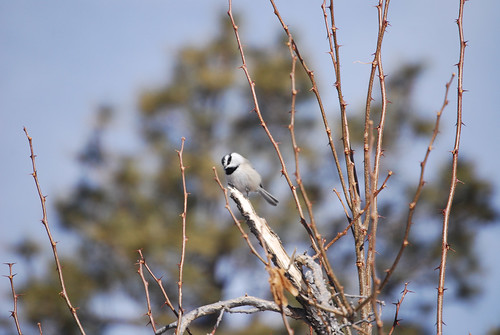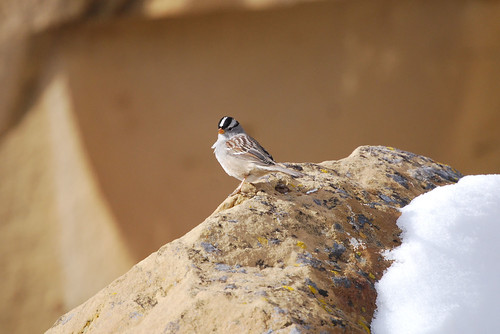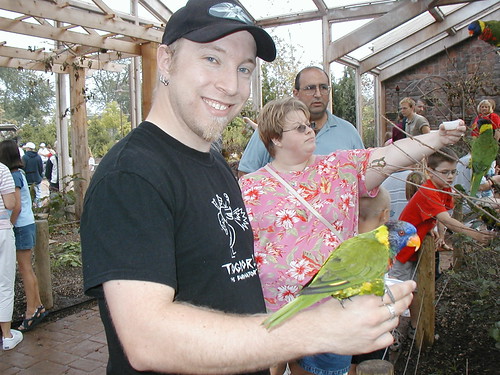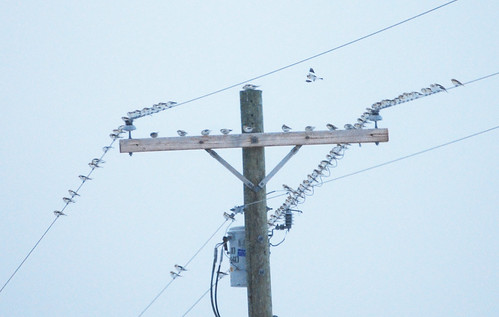
Snow Buntings and Lapland Longspur, Chippewa County, Michigan
Although reports from the
Upper Peninsula through the early winter of 2007-2008 indicated a relatively birdless season, my scheduled trip to the Sault Ste. Marie area (known as the Soo) went forth as planned. Normally a hot spot for winter specialties such as Snowy Owl, Great Grey Owl, Northern Hawk-Owl, Red and White-winged Crossbills, Common and Hoary Redpolls, and Bohemian Waxwings, this winter was anomalous in birding history for the Soo, with the winter finch irruption perhaps a reason for reports of unvisited feeders, while the missing winter raptors and owls still remains somewhat of a mystery.
Still, the promise of UP regulars such as Gray Jay, Boreal Chickadee and Sharp-tailed Grouse was too strong a temptation for our group, and thus nine of us set out for two full days of birding the eastern end of the Upper Peninsula. Our group consisted of Dan Sanders, Ben Warner, Lori Patterson, Linda Benner, Beth Mitchell, Michael Dietrich, Dave Ressler (from Pennsylvania) and my dadl, with yours truly serving as trip leader.
Our first birding stop was at a residence in Midland, Michigan, that had been hosting a Varied Thrush. The bird was not to be found, apparently having vacated the location the day before. A stop at the nearby Chippewa Nature Center allowed for a nice lunch break and for our West Virginia/Pennsylvania contingent to meet up with the Columbus crew. The Chippewa Nature Center features an excellent set of feeders, allowing for great viewing of chickadees, titmice, tree sparrows, downy and hairy woodpeckers, both nuthatches, and just before we left, a great view of a Cooper’s hawk. The group of juncos present at the feeders including one Oregon Junco as well. Light was fading when we hit the Mackinac Bridge, and a stop to scan distant open water in the Straights of Mackinac revealed no birds, so we pressed on to the Soo and our lovely accommodations at the Plaza Motor Motel and a good meal at Ang-Gio’s Italian Restaurant, where the manager identified us as birders at a glance and gave us a warm welcome.
We assembled on Saturday at 8 AM and headed off for our first stop, the power plant of Gyrfalcon fame. Unfortunately, the Soo gyr has not been seen in recent years, and this year has been no exception. We still were treated to fine looks at Common Goldeneye, Common Merganser and a female Red-breasted Merganser with a bill deformity, as well as Bald Eagles, both an adult and a juvenile. Our exploration of the back roads south of the Soo resulted in great looks at Sharp-tailed Grouse, Snow Buntings, Common Ravens, and Rough-legged Hawks, as well as a pair of red foxes. A trip to the Dafter Dump added Glaucous and Herring Gull to our list, as well as one of the highest concentrations of ravens in one place most of us had ever seen. Oh, and yet another Bald Eagle – we would end up seeing Bald Eagles every day of the trip. A house near the dump featured good feeders, and an opportunity to have excellent views of Pine Grosbeaks. Later in the afternoon, another house with a good feeder added an experience no trip to the UP is complete without – getting stuck in the snow on the side of the road! Fortunately, the homeowner was able to haul out the unlucky vehicle with his truck. His feeders also gave us the first Common Redpolls of the trip, and a dark morph Rough-legged Hawk was observed in the distance.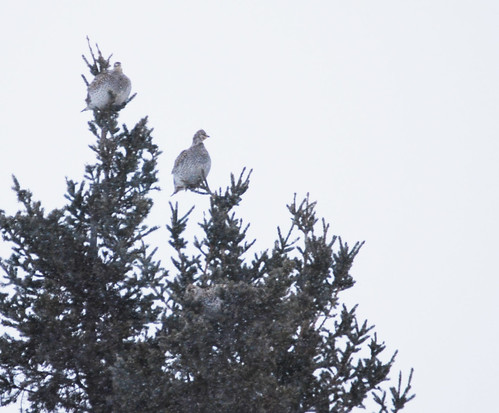
Sharp-tailed Grouse
Much of the day was spent observing mainly empty feeders, a testament to the lack of birds in the Soo this winter. Even the famed feeders at the Dunbar Forest Research Center, known for concentrations of redpolls, grosbeaks and other winter finches, only attracted a handful of Black-capped Chickadees, a Red-breasted Nuthatch and a Hairy Woodpecker. No owls or even Northern Shrikes were present. The only sparrows observed in the UP were the Snow Buntings, although one flock did contain a probable Lapland Longspur. Still, the flocks of hundreds of Snow Buntings was a crowd-pleaser, especially when they perched on telephone wires for excellent viewing.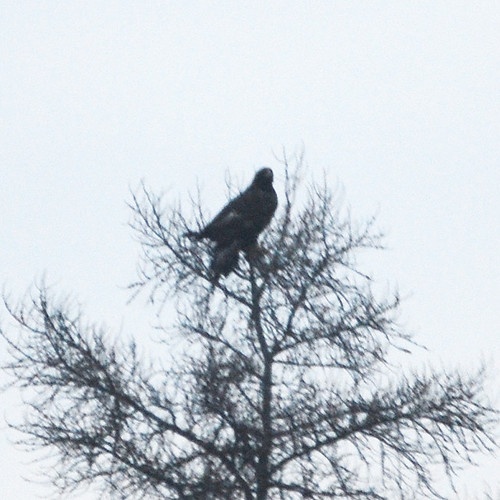
Juvenile Golden Eagle
The main destination on Sunday was Hulbert Bog for boreal birds, with the rest of the day up for grabs. On the way to Hulbert, we happened across a juvenile Golden Eagle, which is a winter rarity for the UP. At Hulbert, we stopped at one house with good feeders to examine a large flock of redpolls, hoping for the Hoary Redpolls that had been reported at Hulbert Bog on eBird. Our study of the redpolls was cut short when the irate homeowner decided to hurry us along by firing off warning shots from a rifle. We prudently decided that since the birds had all scattered from the rifle shots, we’d best be moving along ourselves. This may mark a first for the Avids in terms of being asked to move along.
Potential gunshot wounds were quickly forgotten as we stopped along the road in the bog where we observed a group of ravens and crows foraging on the snow banks (along with another Bald Eagle perched nearby). Hearing chickadees calling, we got out and attracted a flock to our location by spreading some seed along the banks. Soon, several Black-capped Chickadees had swarmed to our location. Two Gray Jays flew by, but did not hang around at first. We played the call of a Boreal Chickadee, and soon after, a single Boreal Chickadee came by to check us out, and everyone had great views of this handsome little bird. We then played Gray Jay calls, and attracted the pair we had seen earlier back to our location. Although we tried to tempt them in close with unsalted peanuts, they did not seem to trust us and stayed at the tops of trees. Still, we had good looks at these birds.
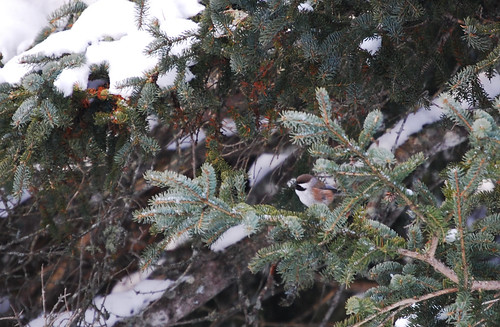
Boreal Chickadee, Hulbert Bog
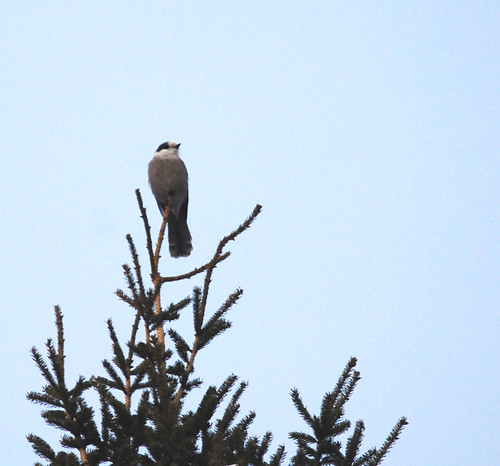
Gray Jay, Hulbert Bog
Although the birding wasn’t up to the standards of a normal Soo winter, the trip was still a success, with nearly everyone adding at least one life bird to their lists. Boreal Chickadee, Gray Jay, Pine Grosbeak, Snow Bunting, Rough-legged Hawk, Glaucous Gull, and Sharp-tailed Grouse were all life birds for members of our group. (Gray Jay, Boreal Chickadee and Sharp-tailed Grouse were my lifers, while I also added several birds to my year list and Michigan life list) A total of 28 species for the UP, and 40 for Michigan as a whole for the trip, is a good number for a supposedly birdless year.





